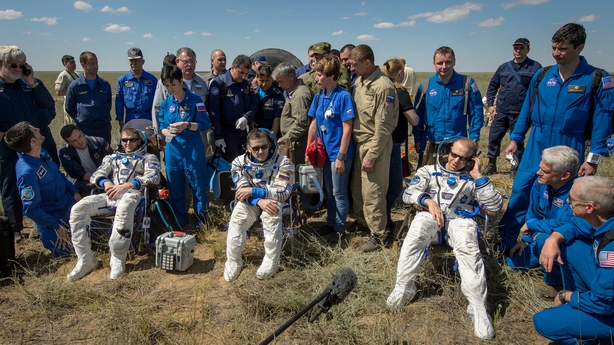British astronaut Tim Peake has returned to Earth in dramatic style after ending the six-month International Space Station (ISS) mission that earned him an honour from Queen Elizabeth for "extraordinary service beyond our planet".
His Soyuz space capsule parachuted down to a remote spot in the vast scrubland steppe of Kazakhstan, landing at 10.15am Irish time.
First reports said the craft had landed on its side, having been caught by the wind. This is not unusual, according to mission controllers.

Travelling with Major Peake were crew mates, US astronaut Colonel Tim Kopra and Russian cosmonaut Yuri Malenchenko
A rescue and recovery team raced to the landing site over 400km south west of the major city of Karaganda.
The men were pulled one-by-one from the Soyuz and placed in seats.
Major Peake had his eyes closed and looked exhausted at first, but then smiled and gave a thumbs up to waiting reporters.
Asked how he felt, he said: "Great, thanks. It was incredible - the best ride I've been on ever.
"I'm just truly elated. The smells of the Earth are so strong. It's just wonderful to feel the fresh air.
"I'm looking forward to seeing the family now."
He added that spending 186 days on the International Space Station was a "life changing experience" and he was now contemplating treating himself to a "pizza and cold beer".
At exactly 6.52am the spacecraft that was to carry the crew back to earth undocked from the International Space Station.
Sprung hooks attaching the Soyuz TMA-19M to the space station were released to free the craft, which took the three men into orbit on 15 December.
An outside camera showed the spacecraft backing away from the space station with the Earth turning slowly below.
Some four hours earlier Major Peake and his crewmates scrambled from the space station into the Soyuz.
#Soyuz parachutes to a landing in Kazakhstan bringing home crew from @NASA, @ESA and @Roscosmos after 186 days. https://t.co/ZUETz7nqp1
— Intl. Space Station (@Space_Station) June 18, 2016
Three humans are in #Soyuz spacecraft and are headed to Earth. Watch their landing at 4am ET https://t.co/KX5g7yYnYG pic.twitter.com/na8PAINAX7
— NASA (@NASA) June 18, 2016
Mission controllers from @NASA_Johnson in Houston monitor #Soyuz undocking activities. pic.twitter.com/HTMMsEbBqA
— Intl. Space Station (@Space_Station) June 18, 2016
Major Peake was the first British astronaut to be sent to the ISS by the European Space Agency (ESA).
The father-of-two took part in more than 250 experiments, performed a space walk, ran the London Marathon on a treadmill, and inspired more than a million schoolchildren.
It is time to go home for British astronaut, Tim Peake, after a busy few months at the International Space Stationhttps://t.co/f6Dc6O4vLL
— RTÉ News (@rtenews) June 18, 2016
The trip home involved a hair-raising plunge through the atmosphere in the tiny middle section of the Soyuz, the descent module.
Friction on the spacecraft's heat shield slowed its speed from 28,000kp/h to 827kp/ and raised the outside temperature to 1,600C.
The rapid deceleration pushed the crew back into their shock-absorbing seats with a force of around five gee - five times normal Earth gravity
One Nasa astronaut, Doug Wheelock, has described the experience of a Soyuz descent as "like going over Niagara falls in a barrel, but the barrel is on fire".

